This month, Rand Bellavia takes a look at his growing longbox, and reflects on comics released in August in 1979, 1984, 1989, 1994, 1999, 2004, 2009, and 2014! Rand Bellavia is back to share his fond memories of decades of comic collecting and reading in this month’s Random Access Memory.
August 1979
Iron Man 128

This was a bad month to be an Avenger. First and foremost, Tony Stark got really drunk:

Always up for a challenge, Hawkeye comes from behind to win the “Bad Role Model” sweepstakes.
Avengers 189
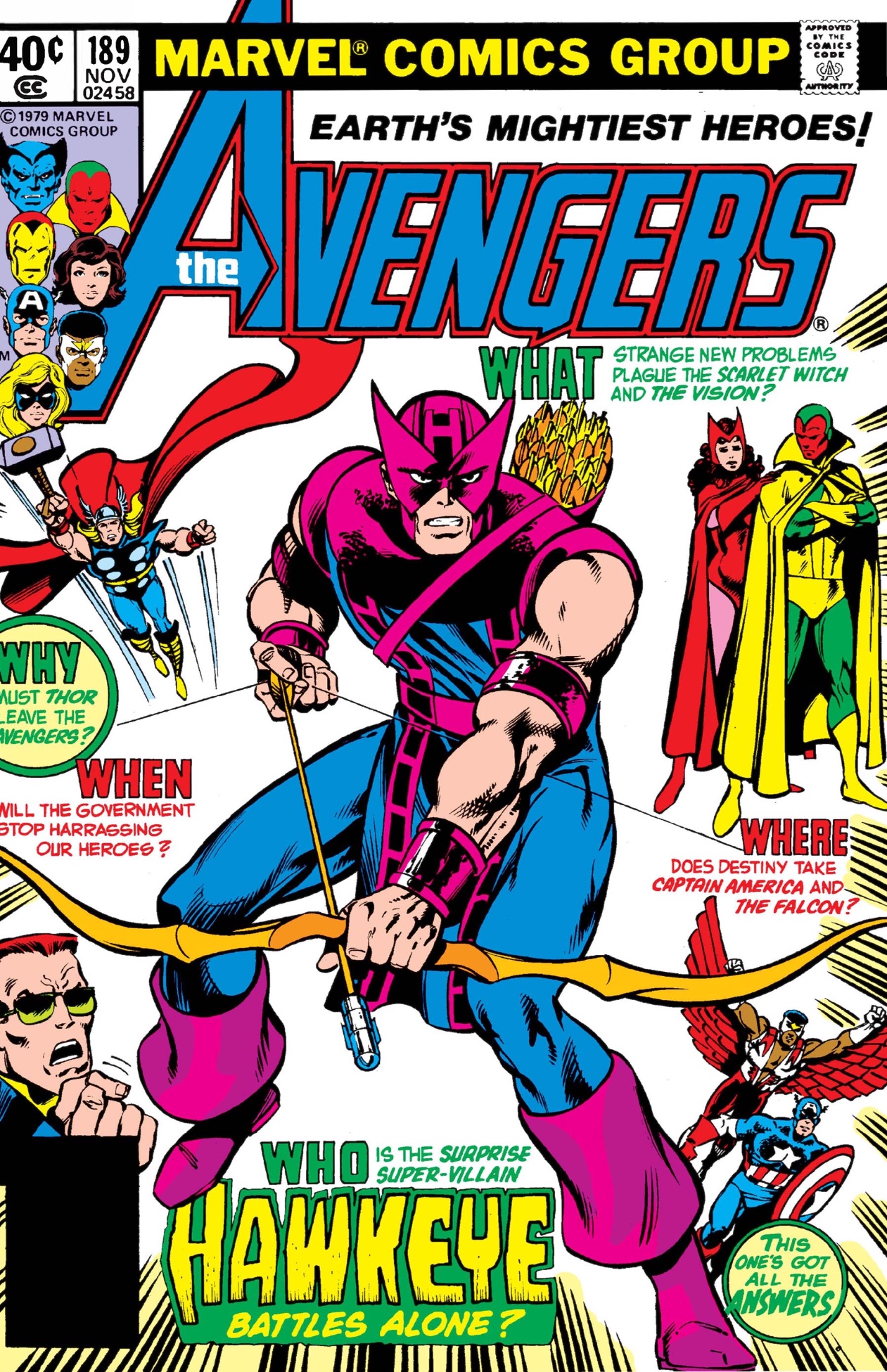
Clint starts things off by being a total asshat to the Falcon:
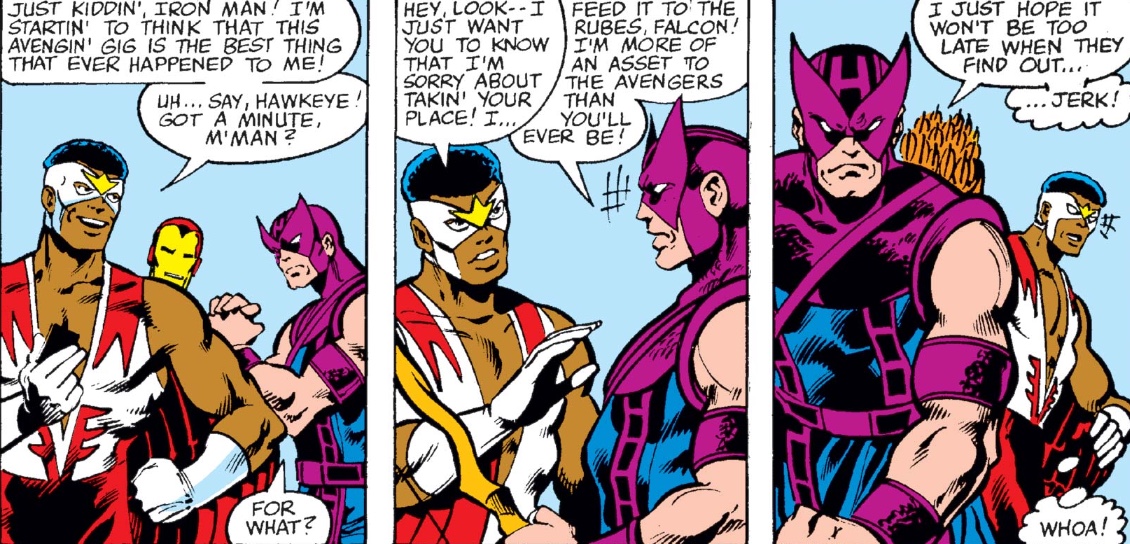
Yes, the Falcon did replace Hawkeye on the team, but he was forced there by the government. In fact, Falcon originally said no, and only joined the team as a personal favor to Captain America. So it’s not like it was poor Sam’s fault.
Then, Hawkeye works out his frustration by forcing himself on a defenseless Deathbird.
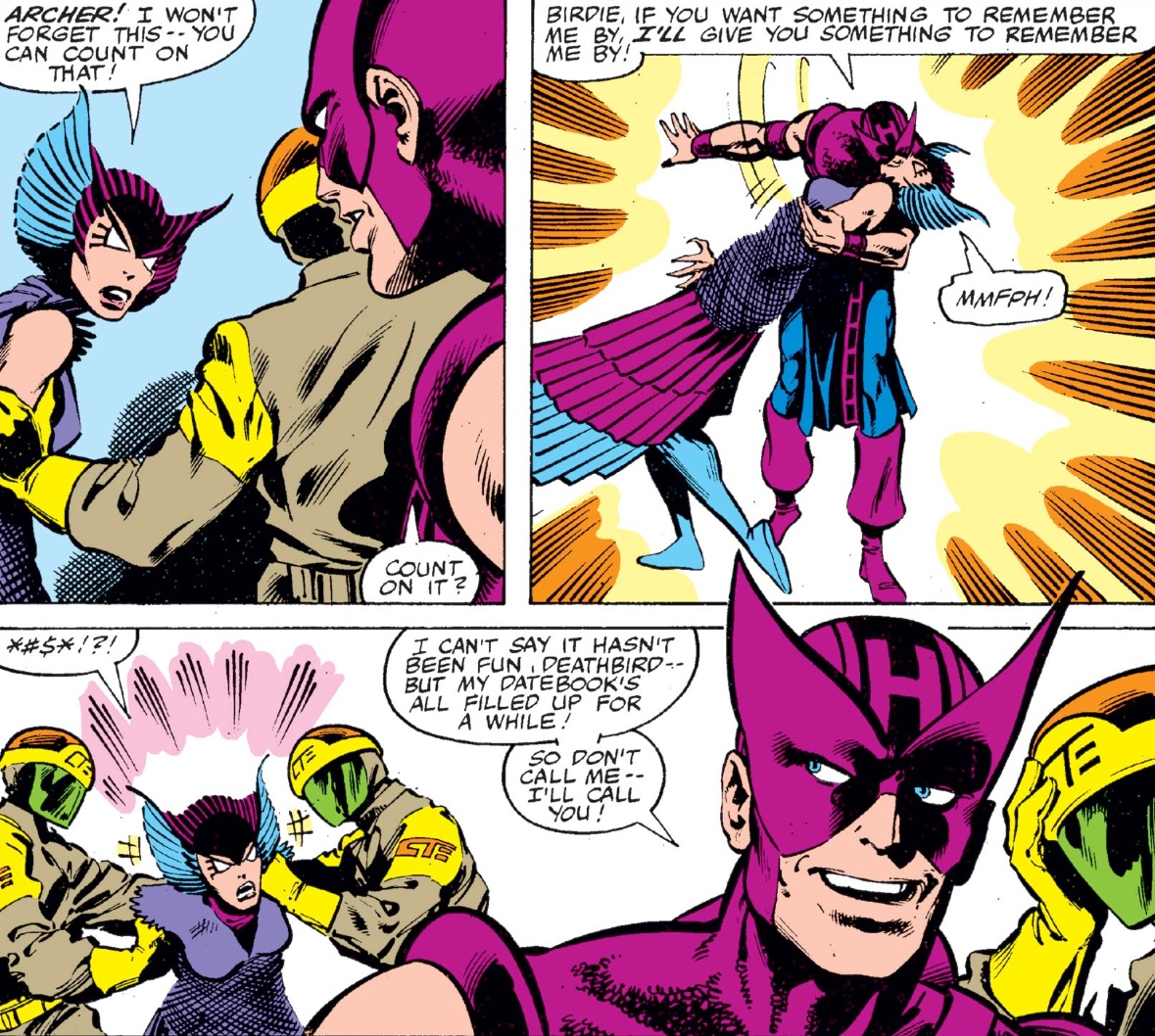
Between Hawkeye and Han Solo, it’s a wonder that any nerds who grew up around 1980 ever had a positive romantic relationship.
Comics I Read From August 1979
- Captain America 239
- Cerebus 11
- Incredible Hulk 241, Annual 8
- Uncanny X-Men 127
August 1984
Dreadstar 14

Jim Starlin has a lot of juice these days as the creator of Thanos. Dreadstar was his super-hero/sword and sorcery hybrid comic. It started out with almost no super-hero trappings — Vanth was originally imaged wearing a Jedi-like hooded robe, but at some point switched to a costume that pretty much screamed, “I may carry a sword, but I’m a super-hero!” Most of the run has been out of print for decades, which is why you’re looking at scans of these overly saturated (and poorly colored) pages.
This issue gave us the big confrontation the book had been promising since the beginning: Vanth Dreadstar vs. the Lord High Papal.
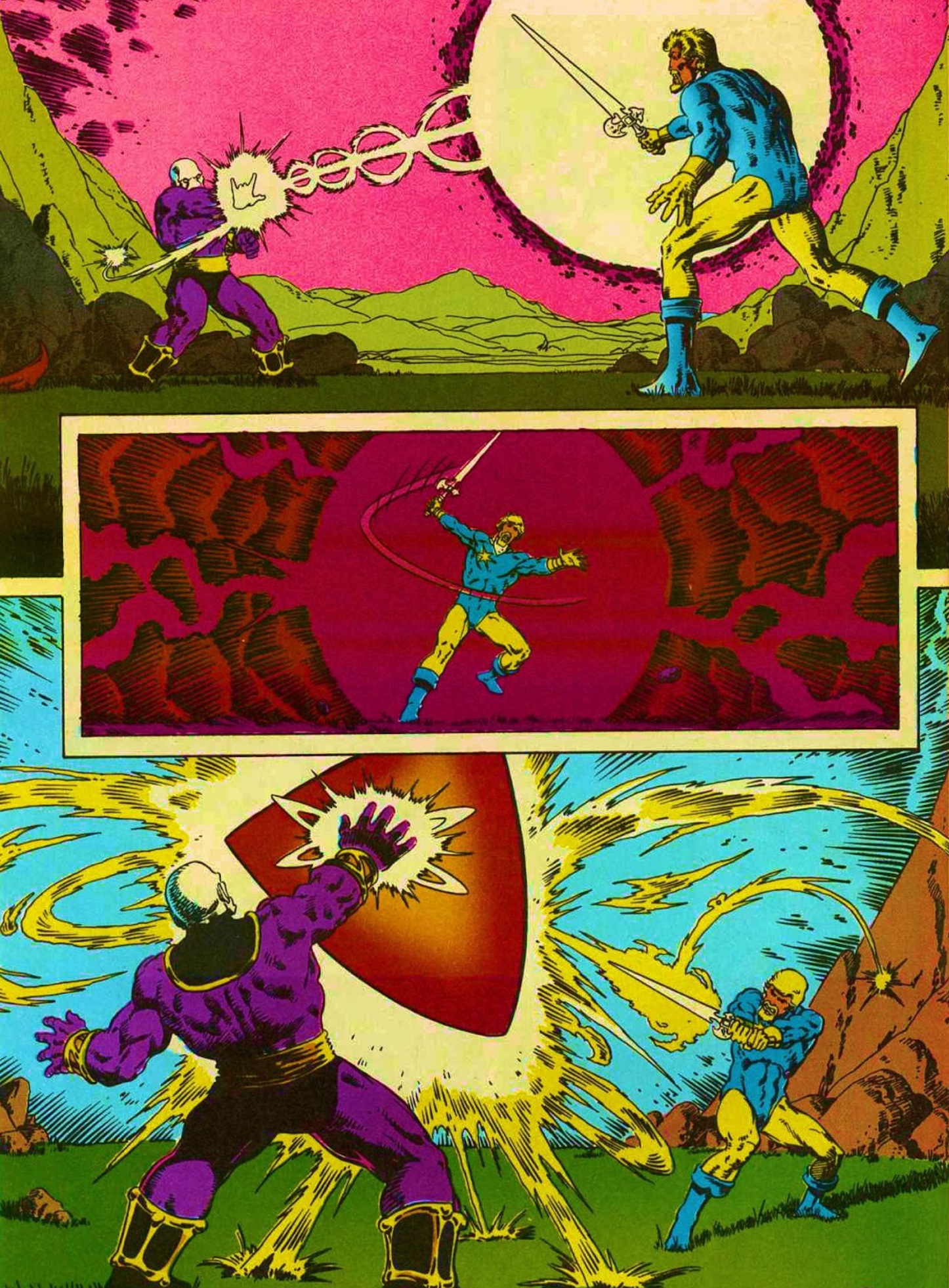
That Jim Starlin sure can draw.

Papal is pretty much a watered-down Thanos (who, to give the man his due, was also created by Jim Starlin), who was pretty much a watered-down Darkseid — that last panel even has Darkseid’s “finder beams.” As Dana Gould said, “it’s like a photo of a drawing of a hologram.”
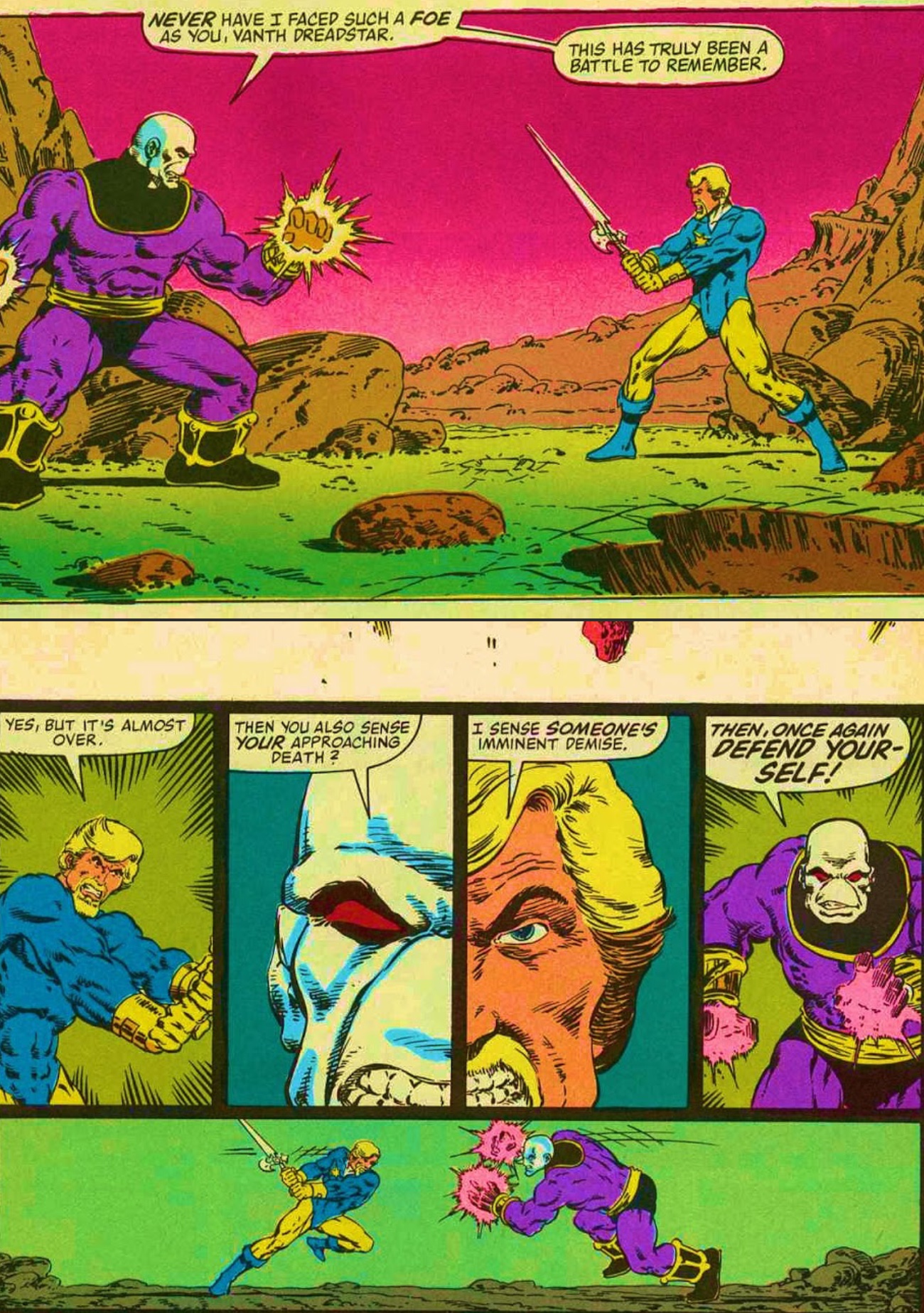
They keep fighting for several more glorious pages, then Papal grabs (or, as he says out loud in a way that no one ever would while fighting to the death, “seizes”) Vanth’s sword, and…

Can’t you feel it? Forthcoming exposition…
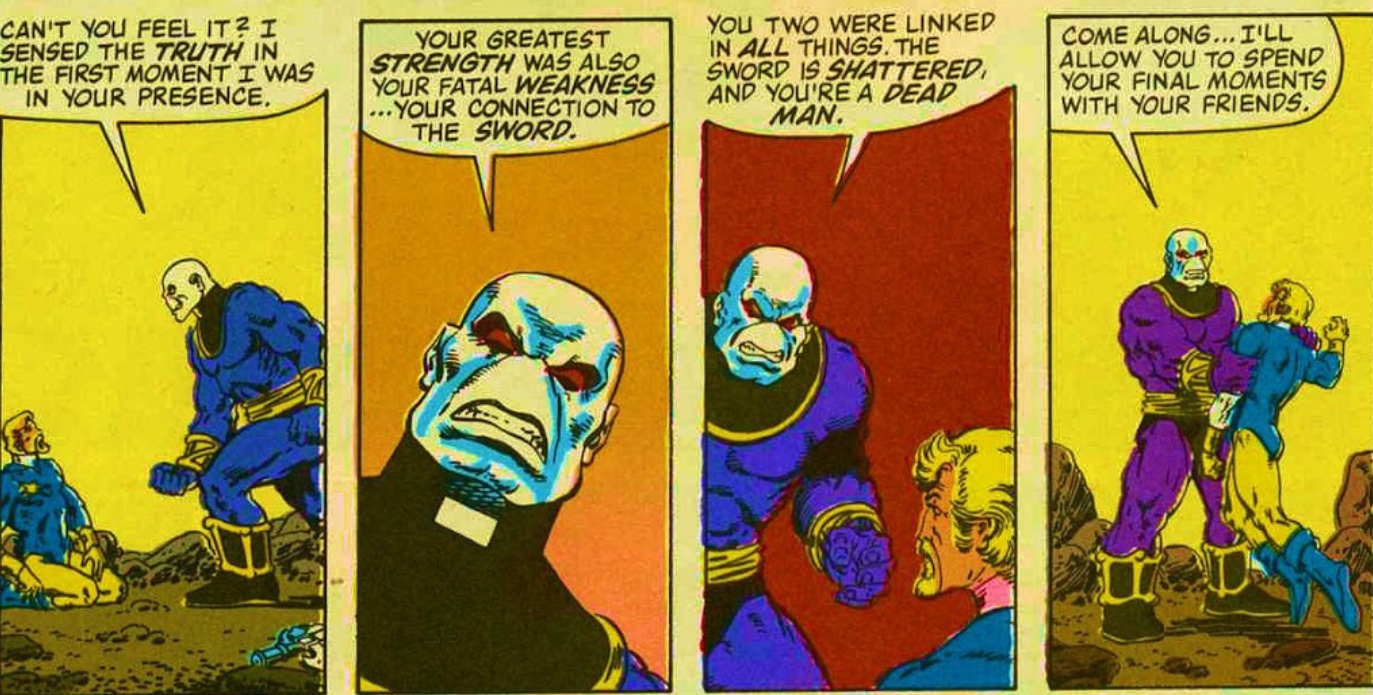
This book came out bi-monthly (if we were lucky) so I had to wait a long time to find out if Vanth was going to get out of this one.
He was.
How? Oh, something about the spirit that inhabited Vanth’s sword being in love with him and bonding with him on a cellular level to save his life — which (conveniently) gave him much more traditionally super-heroic powers (flight, super-strength, invulnerability, etc.), completing the book’s transformation from sword and sorcery to super-hero epic just in time for the story’s third act to begin.
Comics I Read From August 1984
- Alpha Flight 16
- Amazing Spider-Man Annual 18
- Avengers 249, Annual 13
- Beauty and the Beast 1
- Cerebus 65
- Coyote 8
- Defenders 137
- Iceman 1
- Kitty Pryde and Wolverine 1
- Machine Man 3
- Marvel Fanfare 17
- Marvel Super-Hero Secret Wars 8
- Marvel Team-Up 147
- New Teen Titans 3
- Peter Parker the Spectacular Spider-Man 96
- Saga of the Swamp Thing 30
- Six from Sirius 3
- Super Powers 5
- Thriller 12
- Uncanny X-Men 187
- Vigilante 12
- West Coast Avengers 4
August 1989
Doom Patrol 26

Grant Morrison’s Doom Patrol has been getting a lot of overdue attention of late, thanks to the show on DC Universe. Morrison took over the book in issue 19, and while it was pretty delightful from the start, it really started to hit its stride right here.
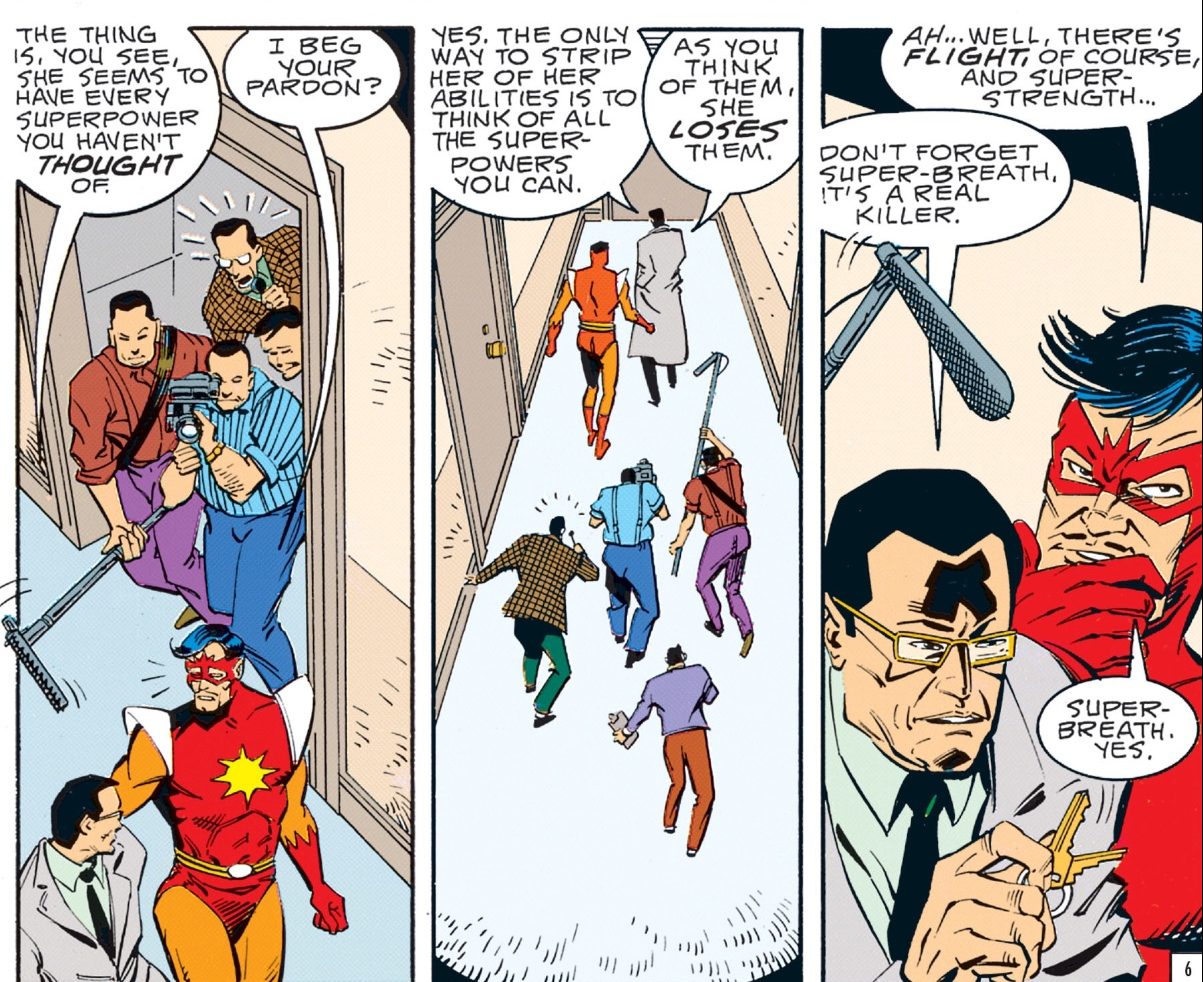
This insane idea never ceases to amuse me. In later issues, you see Robot Man going into battle with her by shouting “Invisibility!” “Super Speed!” “Invulnerability!” That’s just fun.
And the cameras are following that guy because he’s a Japanese superhero who has his own television show. This is 1989, folks, and Grant Morrison is predicting both the rise of reality TV and the pop culture triumph of superheroes.
This issue also introduces Mr. Nobody, certainly the greatest villain of the post-modern era.
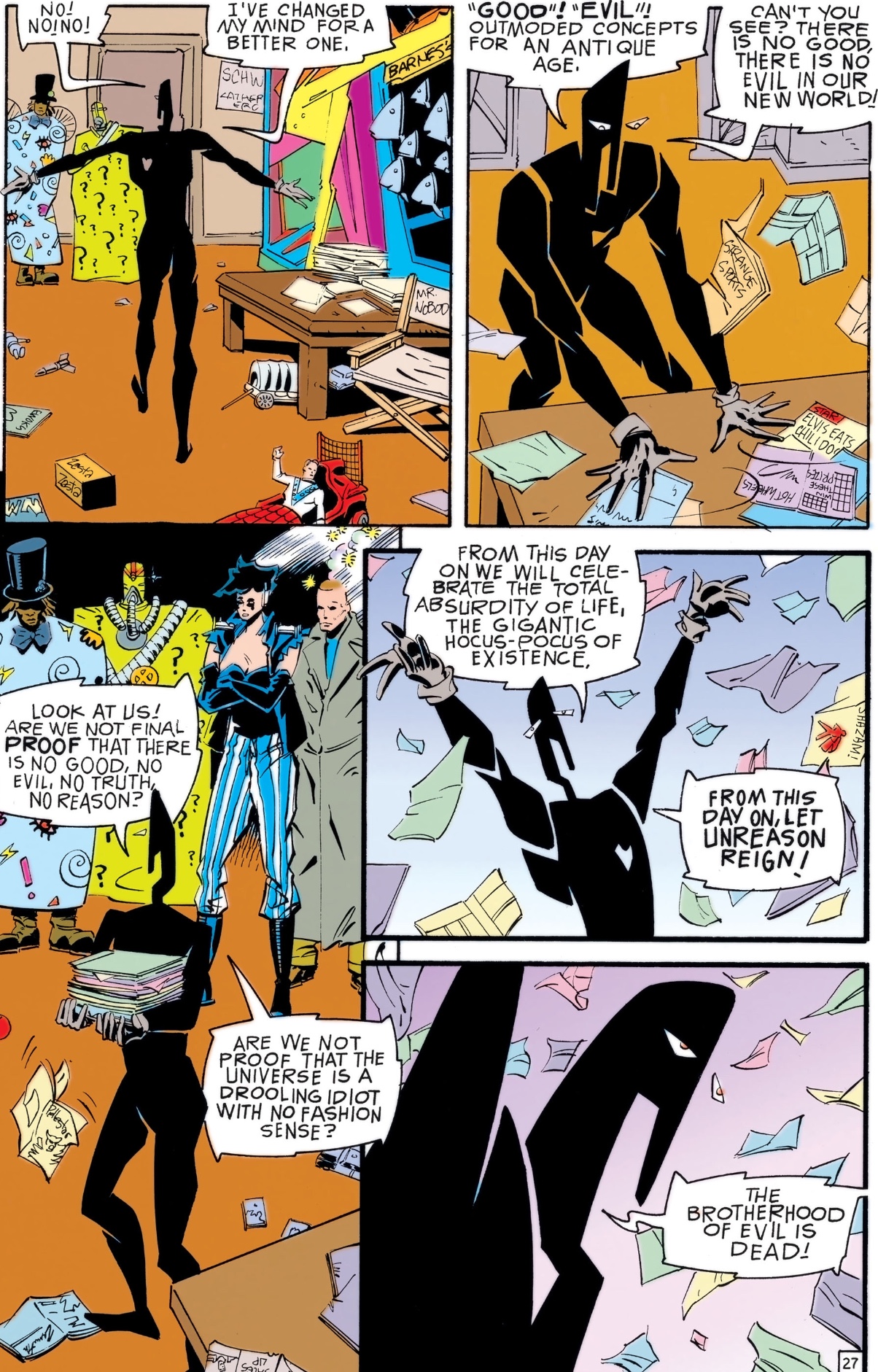
Gaze upon the Brotherhood of Dada and despair.
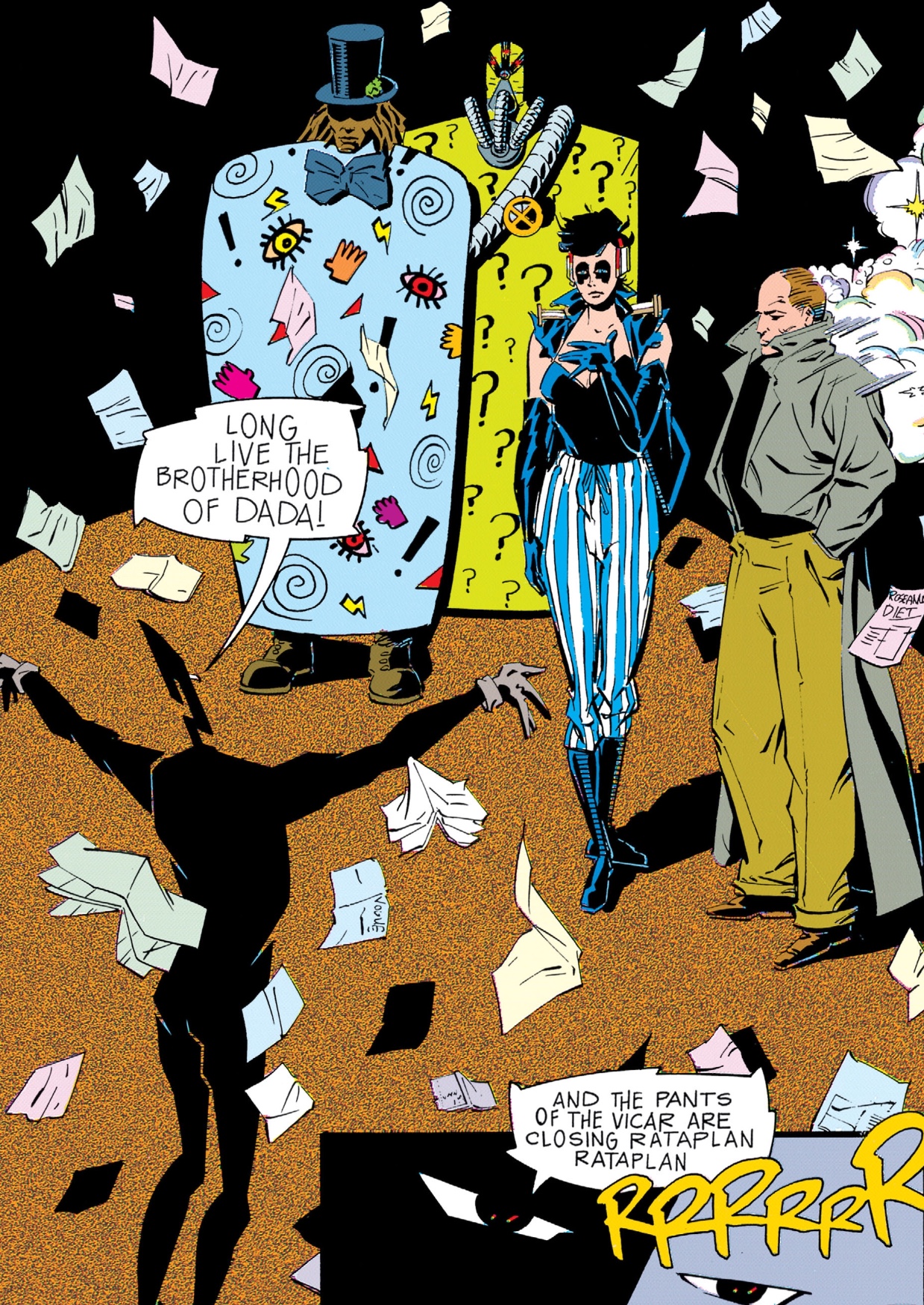
Other Comics I Read from August 1989
- Animal Man 15, 16
- Avengers West Coast 51
- Badger Goes Berzerk 4
- Beautiful Stories for Ugly Children 3
- Cerebus 125
- Dr. Fate 10
- Dreadstar 49
- Gregory 1
- Hawkworld 3
- Hellblazer 23, Annual 1
- Incredible Hulk 362
- Question 30
- Sandman 9
- Secret Origins Special 1
- Skreemer 5
- Whisper 31
- Yummy Fur 17
August 1994
Invisibles 1
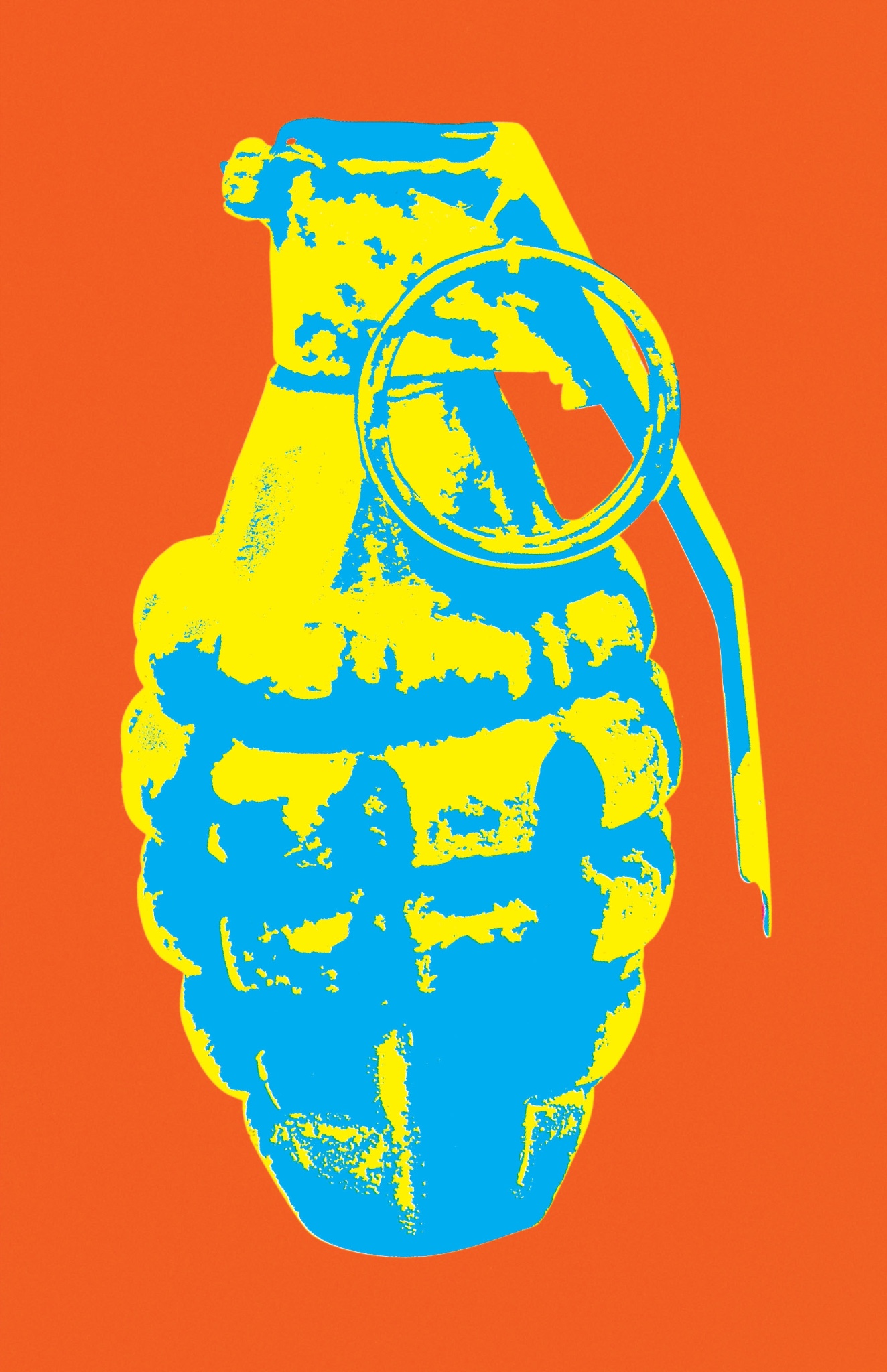
And exactly five years later, Grant Morrison unleashes The Invisibles upon an unsuspecting world (or at least 50,000 of its citizens).
The very first panel clues you in to the fact that the Invisibles is circular, meant to be read (or “played”) on an endless loop.
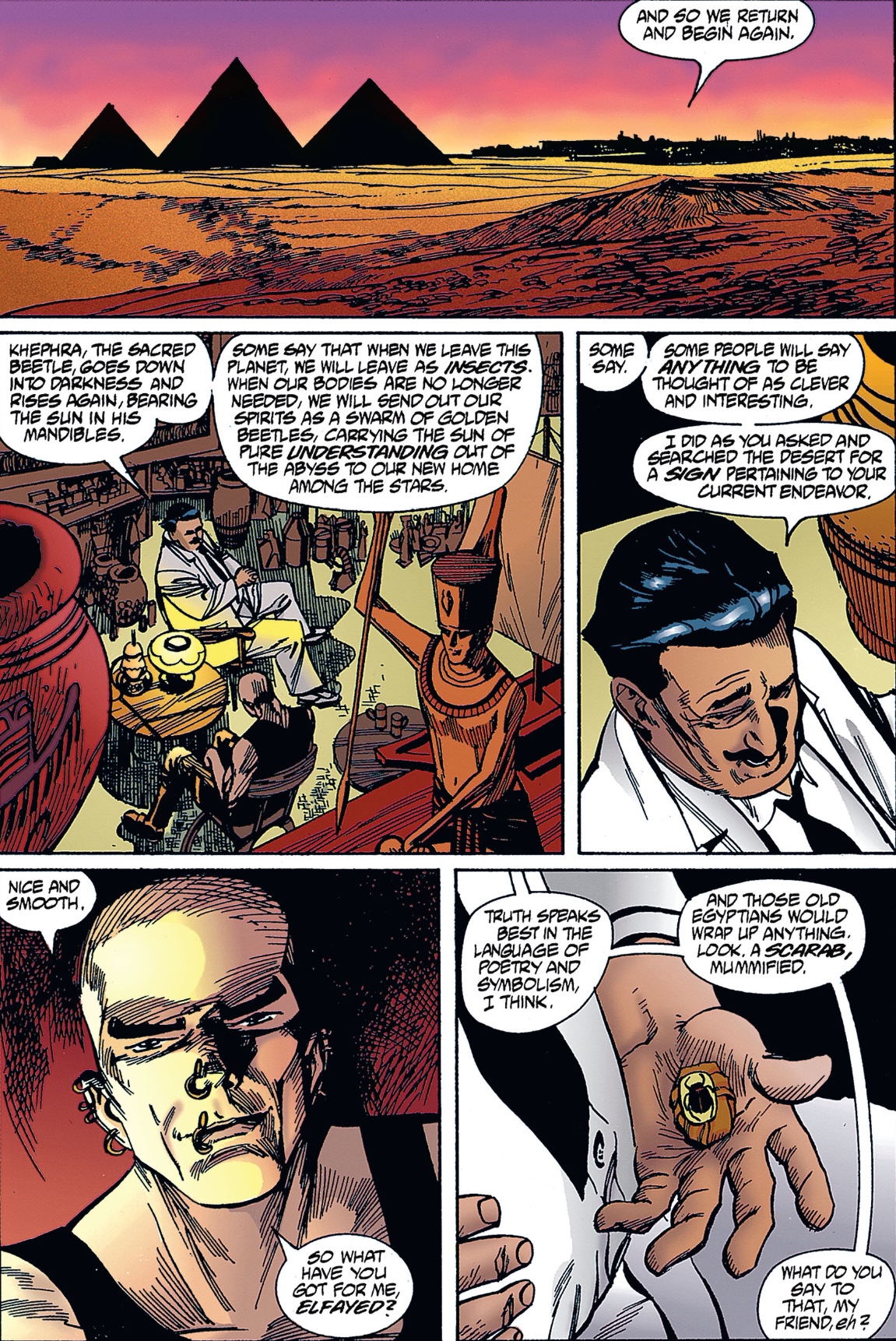
Also on page one we meet King Mob, our Action Hero Archetype. After this opening scene, we don’t see Elfayed again until volume three.
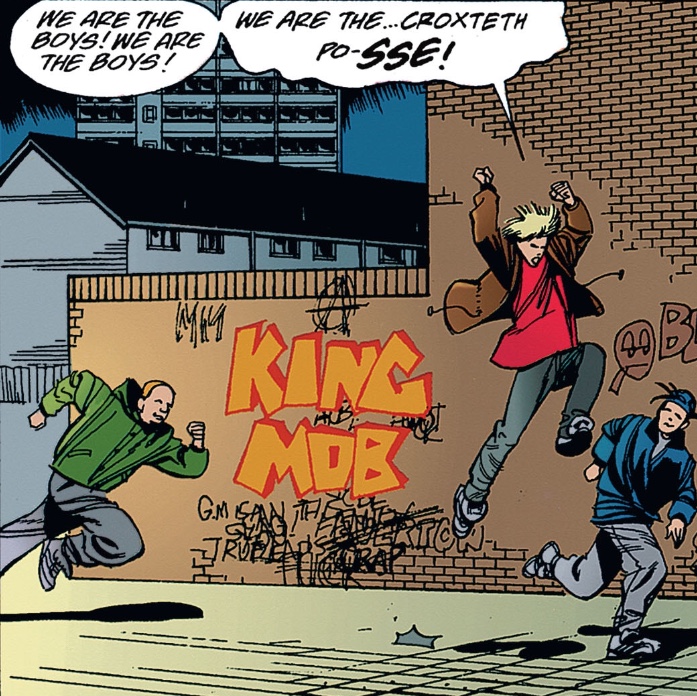
This annoying little juvenile delinquent is, Dane, our point of view character. And, just in case you didn’t notice it in the previous panel:

Once Dane is alone, we get the first sense that something strange is going on as he somehow eavesdrops on a conversation between John Lennon and Stuart Sutcliffe:

This issue is called “Dead Beatles,” referencing John and Stuart (George Harrison was still alive at the time), and cleverly presaged by Elfayed’s speech on the first page. Oddly, King Mob’s first dialogue of the series (“Nice and smooth”) is quoting not the Beatles but rather the Kinks.
The next time we see King Mob, he’s conjuring John Lennon. I’m about as big a John Lennon fan as you’re going to find — my adult life has pretty much been one long John Lennon cosplay — but even I balk at Lennon as deity.
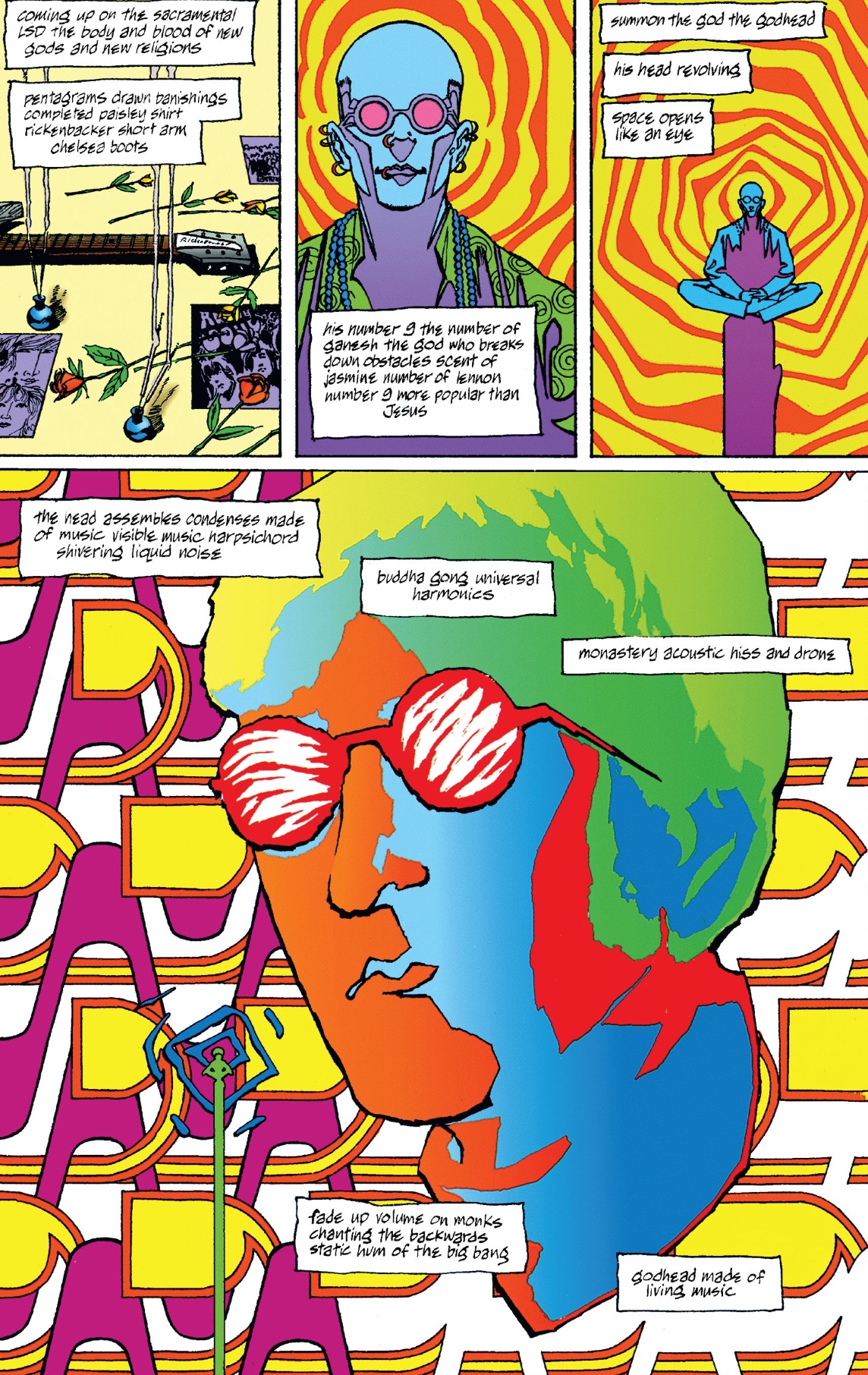
And while he may not ever be as popular, Grant Morrison was certainly higher than Jesus when he wrote this.

Then Dane is captured by the Archons of the Outer Church (it’s a whole thing) and King Mob breaks in Action Hero Style to rescue him.

Here King Mob is presented as the ultimate ultra-cool gun-toting badass, but that (literal) mask begins to (figuratively) slip as the Invisibles progresses. The first sign that things aren’t what they seem is embedded in the second panel above, which is in fact a hypertext link to the twelfth issue (“Best Man Fall”), which tells the life story of the soldier dying on his knees, proving that all deaths matter, and there is no such thing as a minor character.
At the end of the Invisibles, after King Mob will have renounced violence, his life is saved by a stranger who turns to be this dead guy’s wife. Her only appearances in the book are that issue and “Best Man Fall.” Grant Morrison claims that she is the main character of the Invisibles.
Ren and Stimpy Show Special 3

In the fall of 1991, everyone fell in love with Nirvana and Ren & Stimpy. In the wake of these (supposedly unrelated) events Marvel released a surprisingly successful Ren & Stimpy comic, which launched the writing career of Dan Slott.
Slott’s Ren & Stimpy work is absolutely worth seeking out (issue 6 is particularly hilarious and features his first Spider-Man work), but this special is really, well, special. Anyone raised in the early 80s remembers Bantam Books’ Choose Your Own Adventure series. And anyone who had Netflix last year remembers Black Mirror: Bandersnatch. This comic came out between those two titans of popular culture, and reads like this:
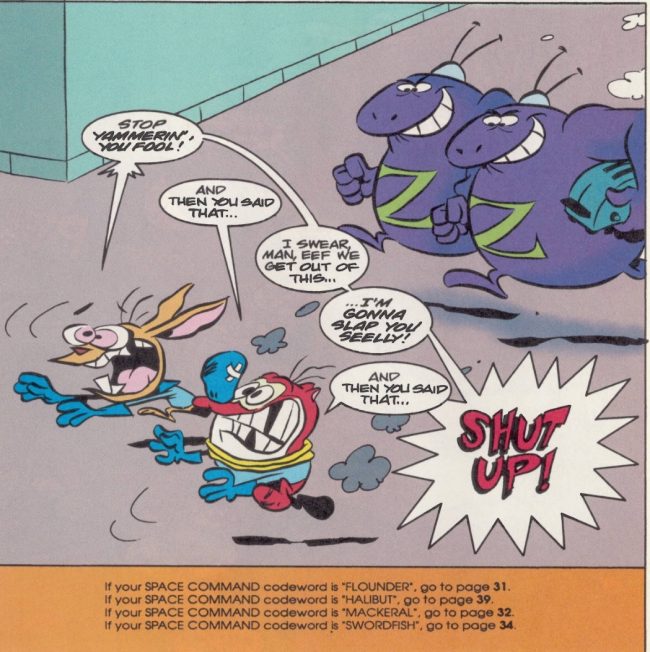
The design of the story is quite clever in that you have Rens and Stimpys from various points in time intersecting, and you are often directed to read the same page multiple times but (depending on how you came to that page) read it from different character’s perspectives.

Of course, this also has the added bonus of effectively making the comic many pages longer than it actually is. Science!
Probably the best bit is when you get directed to page 46:
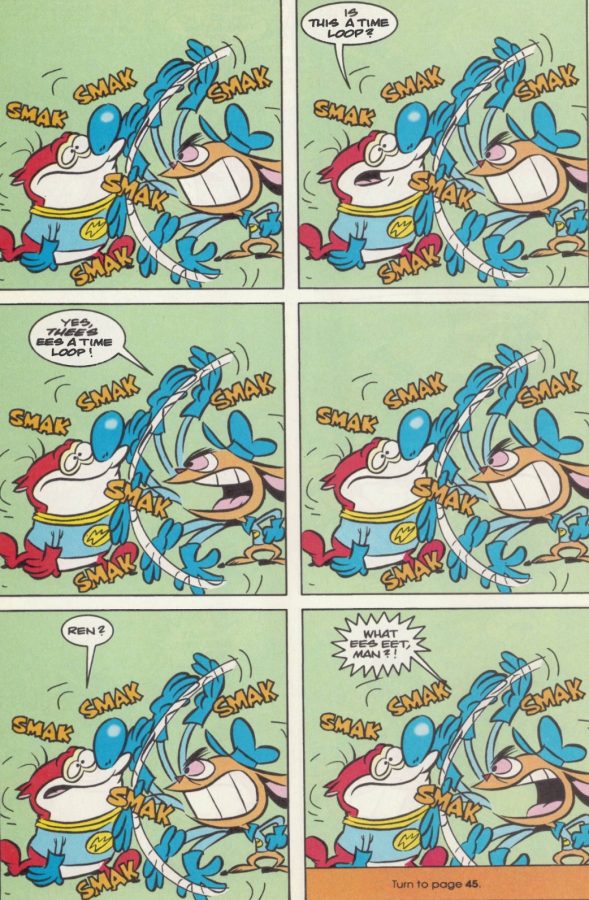
Here’s page 45, which of course spills back to page 46, created an endless time loop, causing you to reboot the comic to continue.

Comics I Read from August 1994
- Amazing Spider-Man 394
- Animal Man 76
- Aquaman 2
- Batman: Legends of the Dark Knight 0
- Cerebus 185
- Concrete: Killer Smile 2
- Demon 0
- Flash 0
- Hellblazer 82
- Hellstorm: Prince of Lies 19
- Incredible Hulk 422
- Instant Piano 1
- Madman Comics 3
- Maxx 10
- Peepshow 6
- Sandman 63
- Sandman Mystery Theater Annual 1
- Shade the Changing Man 52
- Starman 0
- Swamp Thing 147
- Underwater 1
- White Like She 4
August 1999
Dork 7

I’m a pretty big fan of all things Evan Dorkin, but if there’s one comic of his that everyone should check out it’s Dork 7. Dork was a “catch-all” anthology comic that aggregated previously published shorts strips and supplemented them with whatever new stuff he was producing at the time. It was a humor publication, with a lot of really funny stuff — particularly his Fun pages (collections of four-panel gag strips).
While this issue maintains the anthology nature of other issues, it’s more stream of consciousness, and certainly the closest any issue of Dork comes to a cohesive narrative. (Like an episode of Mr. Show, as opposed an episode of Saturday Night Live — and if you’re not familiar with Evan Dorkin, I’m not sure why I think you know what Mr. Show is…)
Also, Dork 7 isn’t particularly funny.
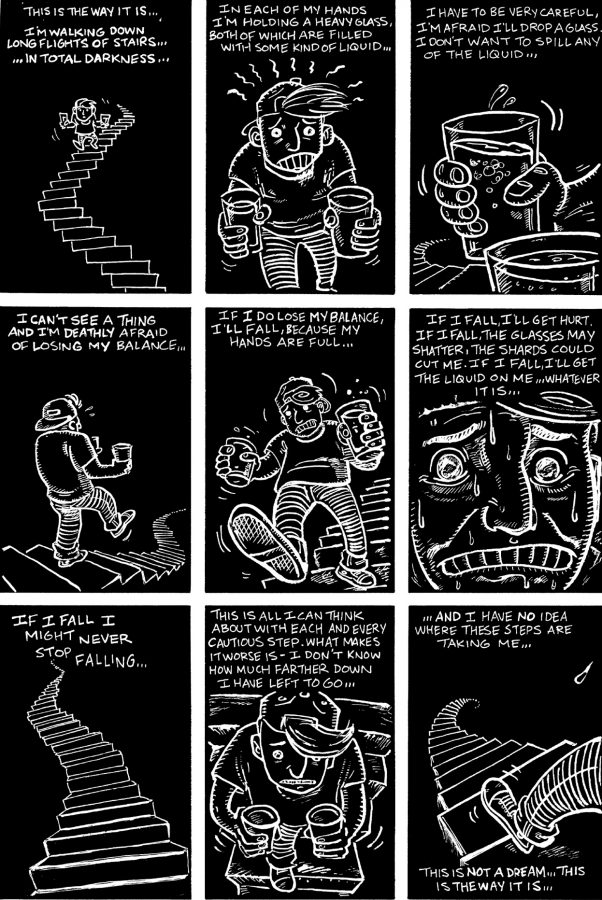
The first half of the issue was previously published in the final issue of the Instant Piano jam comic Dorkin created with Kyle Baker and three other indy comic artists. Dorkin (the character in the comic, and presumably the artist himself) is aware that the reader expects jokes, but his attempts at frivolity are constantly interrupted by a litany of phobias:

Ideas are drawn and abandoned seemingly as quickly as they occur to Dorkin. Here’s his solution to sports fans who riot after their team wins the big game:

Even his attempts to return to tried and true bits like Fisher-Price Theater are interrupted by his confessional avatar.
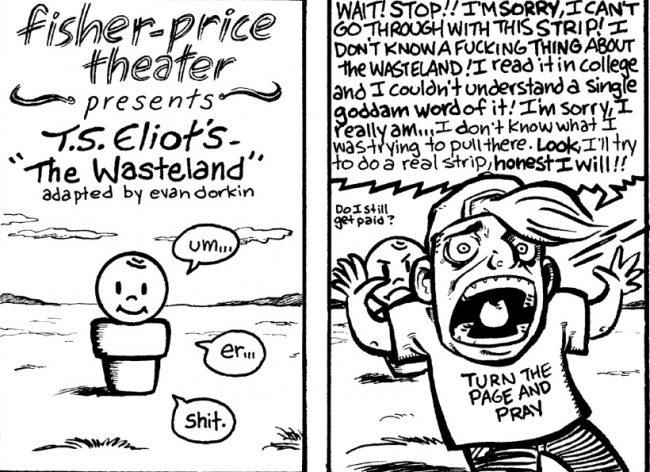
Eventually his partner (artist and writer Sarah Dyer) finds her way into the strip, if only to make fun of Dorkin from off-camera:
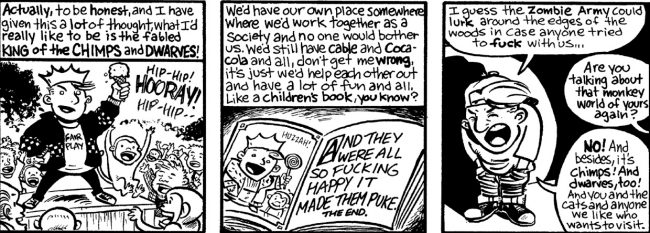
What makes this work — for me, at least — is how many of these ideas resonate. I think about this next one every time I have the unfortunately experience of watching a show with a laugh track.
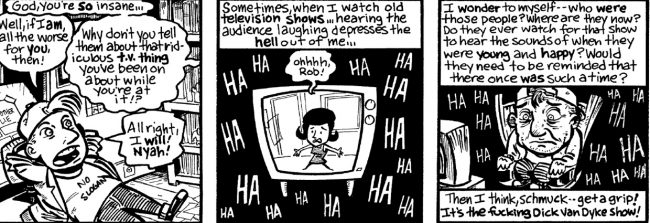
The second half of the comic (which was newly created for this issue) expands on the confessional nature of the previous piece by placing Dorkin in an actual therapy session:

Disturbed by these revelations, Dorkin tries to get back to the serious work of being funny, and finds himself haunted by three stereotypically negative versions of himself.

These represent (left to right in the fourth panel above) Evan Dorkin the Gen X Moron, Evan Dorkin the Insufferable Artiste, and Evan Dorkin the Greedy Sellout. They torture him until he can’t take any more. Then Sarah finally makes an on page appearance:
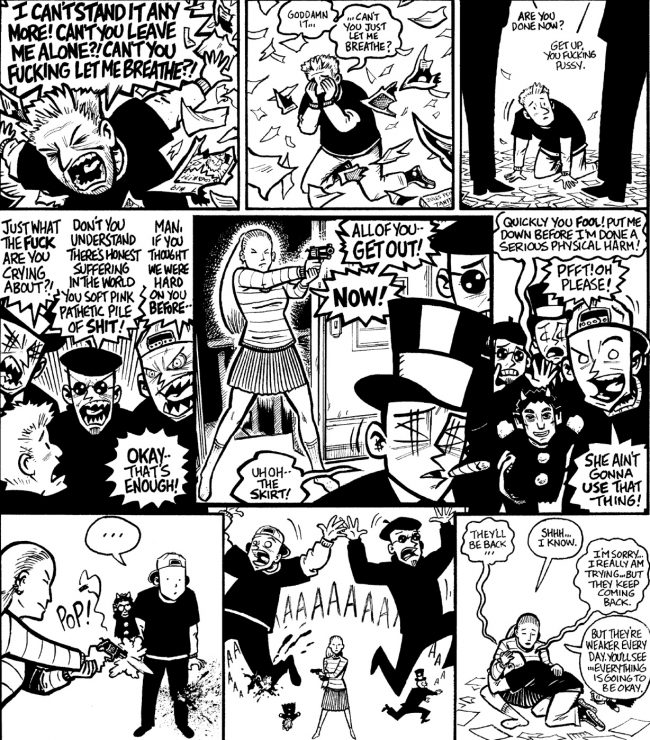
Other Comics I Read from August 1999
- 100 Bullets 3
- Action Comics 758
- Authority 6
- Avengers 21
- Avengers Forever 11
- Captain America 22
- Cy-Gor 1
- Finals 2
- Flash 153
- Flash/Green Lantern: The Brave and the Bold 1
- Flinch 5
- Grendel: Devil Child 2
- Hellblazer 141
- Hitman 42
- Hourman 7
- Inhumans 10
- Invisibles 7
- JLA 34
- JLA: Foreign Bodies
- JSA 3
- Preacher 54
- Promethea 3
- Sam and Twitch 1
- Sin City: To Hell and Back 2
- Starman 58
- Superman Adventures 36
- Tomorrow Stories 1
- Top Ten 2
- Transmetropolitan 26
August 2004
We3 1
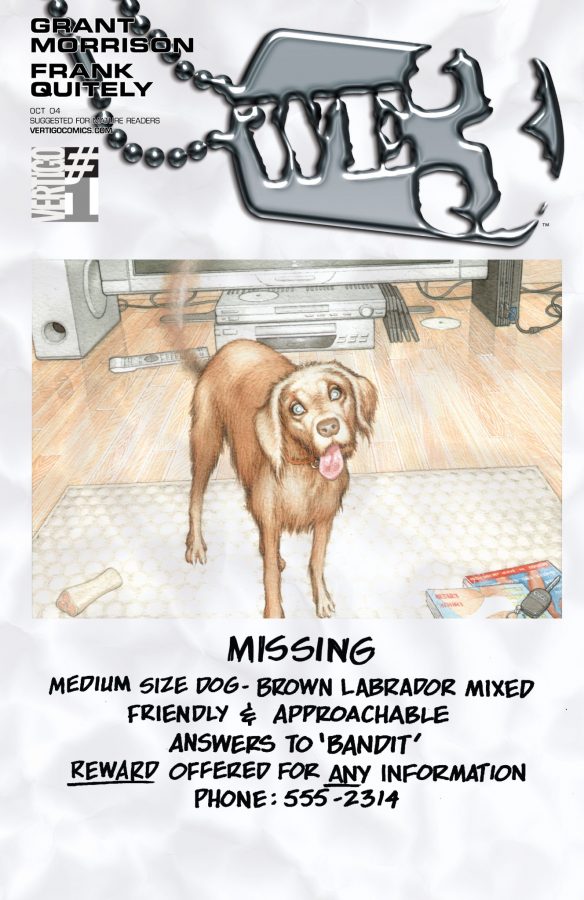
In 2004, the idea of using video game controller to wage war was a lot more science-fictional. Even now drone warfare is more of a “death from above” notion. We3 assumes that the military cannot wait for robotics to catch up to our ground war needs, and imagines animals as weapons.

We3 stands for Weapon 3, presumably the third iteration, but conveniently also made up of three animals:

The animals ability to speak is an emotional gut punch right from the start.
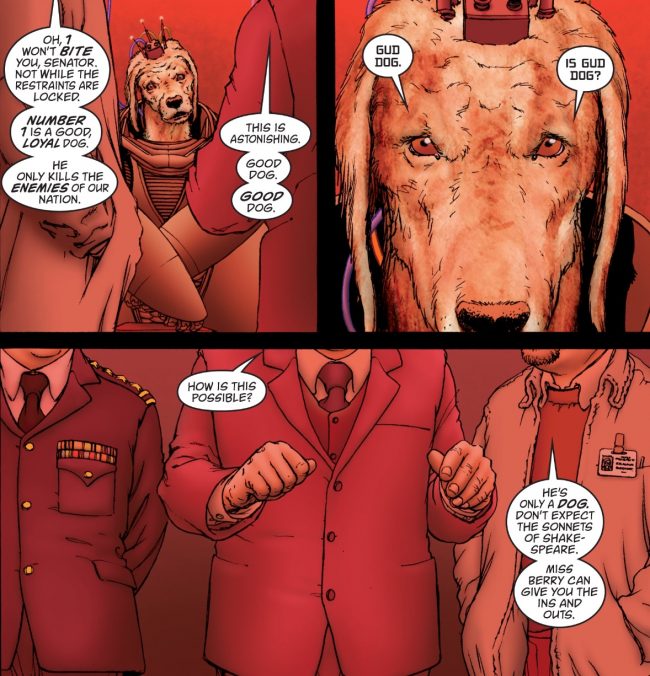
Brilliantly, the ability to talk like humans doesn’t give then the ability to think or process information like humans. Our dog is obsessed with finding favor, our cat wants to kill everything, and our rabbit just wants a nice carrot. So the only difference here is that they can let us know those things in English.
The perfectly named Mr. Washington responds to all of this with alarming candor:

The animal’s handler sacrifices herself to allow them to escape, and we realize that we’re looking at a a mash-up of the Incredible Journey and ultra-violent manga as filtered through Grant Morrison and Frank Quitely.
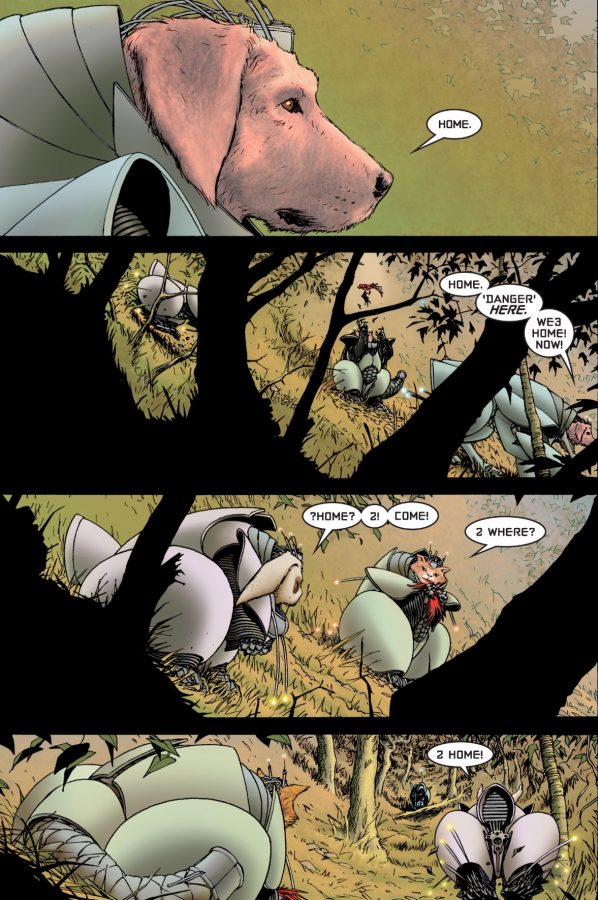
Other Comics I Read from August 2004
- 100 Bullets 52
- Adventures of Superman 631
- Astonishing X-Men 4
- Astro City Special 1
- Authority: More Kev 3
- Avengers 501
- Catwoman 34
- Daredevil 63
- DC Comics Presents: The Atom 1
- Ex Machina 3
- Fantastic Four 517
- Flash 213
- Goon 8
- Gotham Central 22
- Hellblazer 199
- Human Target 13
- Identity Crisis 3
- Incredible Hulk 75, 76
- Invincible 14
- JSA 64
- Losers 15
- Lucifer 53
- Marvel Knights Spider-Man 5
- Plastic Man 9
- Powers 3
- Promethea 31
- Punisher 10
- Runaways 17
- Scratch 3
- Secret War 3
- She-Hulk 6
- Sleeper Season Two 3
- Swamp Thing 6
- Teen Titans 14
- Ultimate Fantastic Four 10
- Ultimate Nightmare 1
- Ultimate Spider-Man 63, 64
- Walking Dead 11
- Wolverine 18
- Wonder Woman 207
- X-Statix 26
- Y: The Last Man 25
August 2009
Batman and Robin 3

Does this cover reference the cover to The Killing Joke? You decide!

It might help to point out that Quitely took a lot of liberties, and was looking at the cover upside down.

We get more great action shots from Quitely, and witness what appears to be Damian Wayne’s first moment of gratitude.

It doesn’t last.
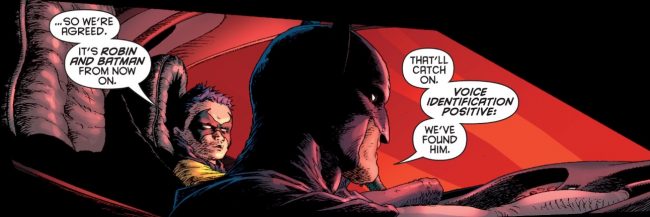
And here’s the girl Robin was looking for, surrounded by fantasic examples of Quitely’s ability to incorporate sound effects into his storytelling.

She is “rescued” by the Red Hood. According to the Killing Joke, the Red Hood was originally worn by the Joker. If you still doubt the Joker cover reference, the Red Hood seen here is later revealed to be Jason Todd, aka Robin — the one the Joker famously beat to death in an issue of Batman that came out a few months after the Killing Joke.
Other Comics I Read from August 2009
- Action Comics 880
- Adventure Comics 1
- Amazing Spider-Man 601-603
- Astro City: Dark Ages Book Three 4
- Avengers: Initiative 27
- Batman Confidential 32
- Beta Ray Bill: Godhunter 3
- Blackest Night 2
- Blackest Night: Batman 1
- Captain America: Reborn 2
- Chew 3
- Daredevil 500
- Dark Avengers 8
- Dark Entires
- Dark Reign: Mr. Negative 3
- Dark X-Men: The Beginning 3
- Destroyer 5
- Detective Comics 856
- DMZ 44
- Ex Machina 44
- Existence 2.0 2
- Fantastic Four 570
- Filthy Rich
- G-Man: Cape Crisis 1
- Ghost Rider: Heaven’s on Fire 1
- Greek Street 2
- Green Lantern 45
- Green Lantern Corps 39
- Hellblazer 258
- Incredible Hercules 132, 133
- Incredible Hulk 601
- Invincible 65
- Invincible Iron Man 16
- Marvels Project 1
- Mighty 7
- Mighty Avengers 28
- New Avengers 56
- Northlanders 20
- Outsiders 21
- Seceret Warriors 7
- Thunderbolts 135
- Ultimate Comics Avengers 1
- Ultimate Comics Spider-Man 1
- Uncanny X-Men 514
- Unknown Soldier 11
- Walking Dead 64
- Wednesday Comics 5-8
- Wolverine: Weapon X 4
- X-Factor 47
August 2014
Multiversity 1
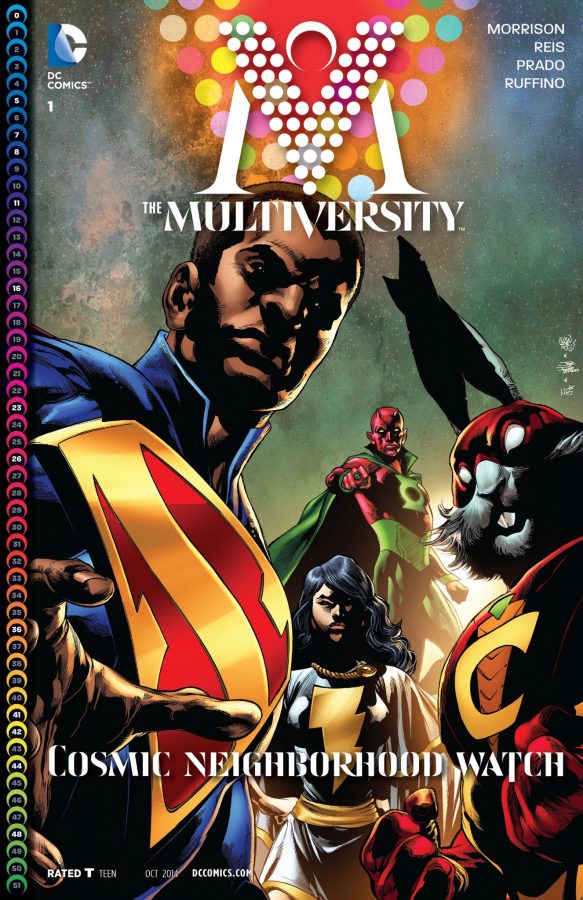
For those who insist that modern-era Grant Morrison super-hero comics are impenetrable: He’s just riffing on Silver Age “Flash of Two Worlds”-style story. This cover from 1966 certainly had a bigger influence on Grant Morrison than Jorge Luis Borges or Terence McKenna:

We open with some solid meta-narrative. This is, after all, a comic about comics — generally, for sure, but here we also reference the specific cover and title of a future issue of Multiveristy.

You will believe that a comic can be haunted! And this isn’t the first time Morrison has asked the reader who’s voice it is they hear as they read.
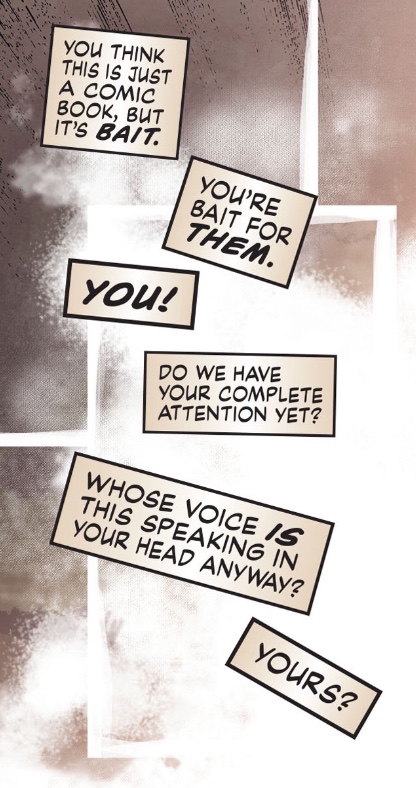
The Gentry — the Big Bad of Multiversity — was the subject of much ridicule, probably because he looked like an inky winged cycloptic egg:
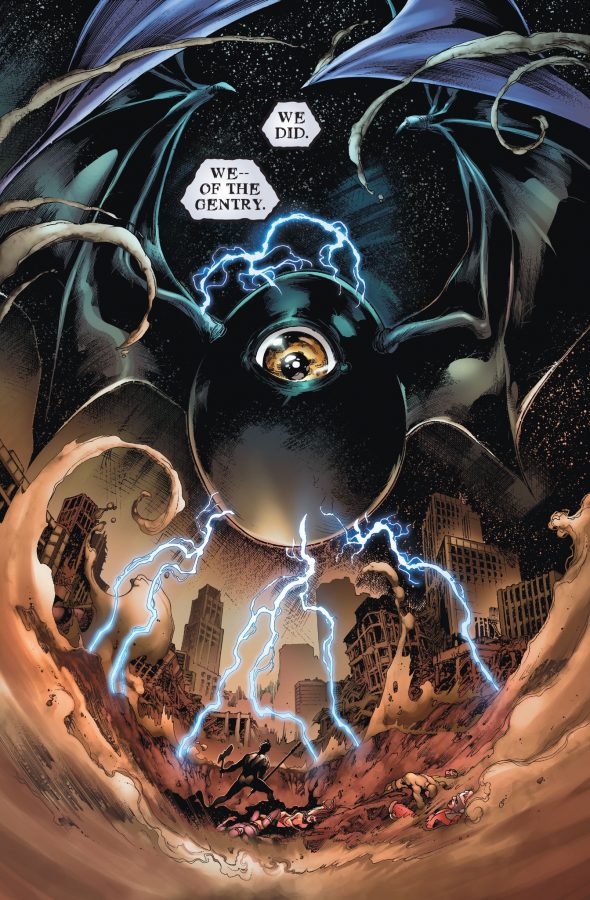
Gentry implies high-birth or nobility, but actually connotes land-owning as much as anything else. The ruling class. Gentrification comes from the same root.
The elevator pitch for Multiversity is that there are 52 different universes in the multiverse, and the history of each universe is published throughout the multiverse as comic books.

“Multiversity” obviously references the multiverse, but it also a portmanteau of multiverse and… what, exactly? Adversity? Perversity? University?
My money is on diversity. It’s not a a coincidence that the bad guys are called the Gentry in the same book where a cis white male doesn’t have a speaking line until page 30.
If that all seems too ponderous for you, there’s also this:
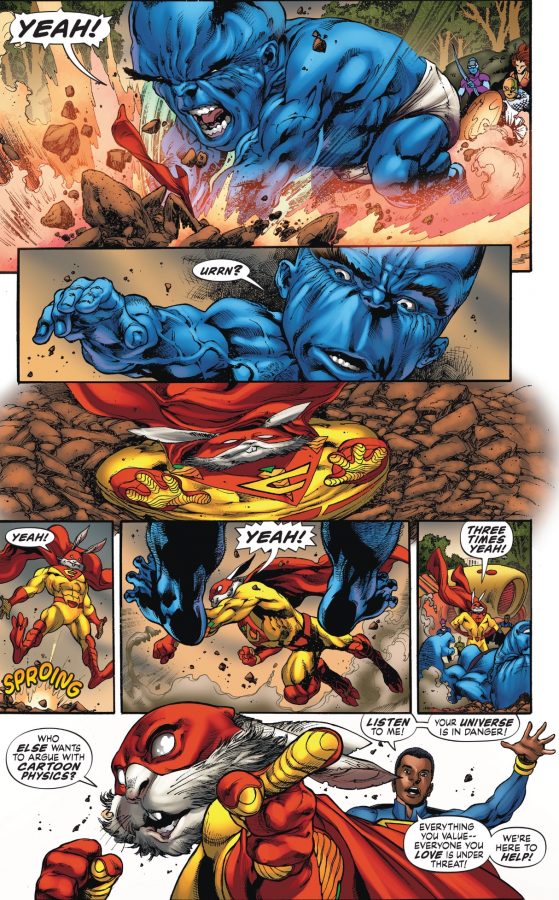
Other Comics I Read from August 2014
- Action Comics 34
- All-New X-Factor 11, 12
- Avengers 34
- Batman 34
- Batman and Robin 34
- Batman/Superman 13
- Black Widow 9
- Brain Boy: The Men from G.E.S.T.A.L.T. 4
- Captain Marvel 6
- Cyclops 4
- Daredevil 7
- Deep Gravity 2
- Dream Police 4
- Fade Out 1
- Goon: Occasion of Revenge 2
- Grayson 2
- Green Arrow 34
- Invincible 113
- Justice League 34
- Kick-Ass 3 8
- Lazarus 10
- Manhattan Projects 23
- Moon Knight 6
- Ms. Marvel 7
- New Avengers 22, 23
- Original Sin 7
- Outcast 3
- Punisher 9
- Revival 23
- Saga 22
- Secret Avengers 7
- Sex Criminals 7
- Spread 2
- Storm 2
- Superior Foes of Spider-Man 14
- Superior Spider-Man 32
- Superman 34
- Supreme: Blue Rose 2
- Thief of Thieves 23
- Trees 4
- United States of Murder Inc. 4
- Walking Dead 130
- Wayward 1
- Where is Jake Ellis? 4
- Wicked and the Divine 3
- Wildfire 3
- Wonder Woman 34
- Zero 10
Dear Spoilerite,
At Major Spoilers, we strive to create original content that you find interesting and entertaining. Producing, writing, recording, editing, and researching requires significant resources. We pay writers, podcast hosts, and other staff members who work tirelessly to provide you with insights into the comic book, gaming, and pop culture industries. Help us keep MajorSpoilers.com strong. Become a Patron (and our superhero) today.


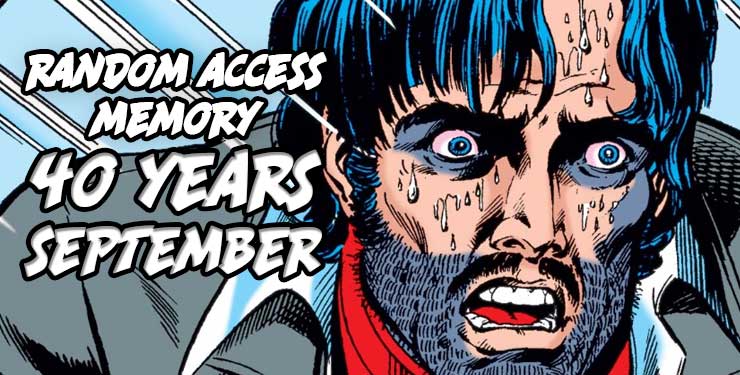
2 Comments
Just saying, this is a fantastic article series!
Much appreciated!